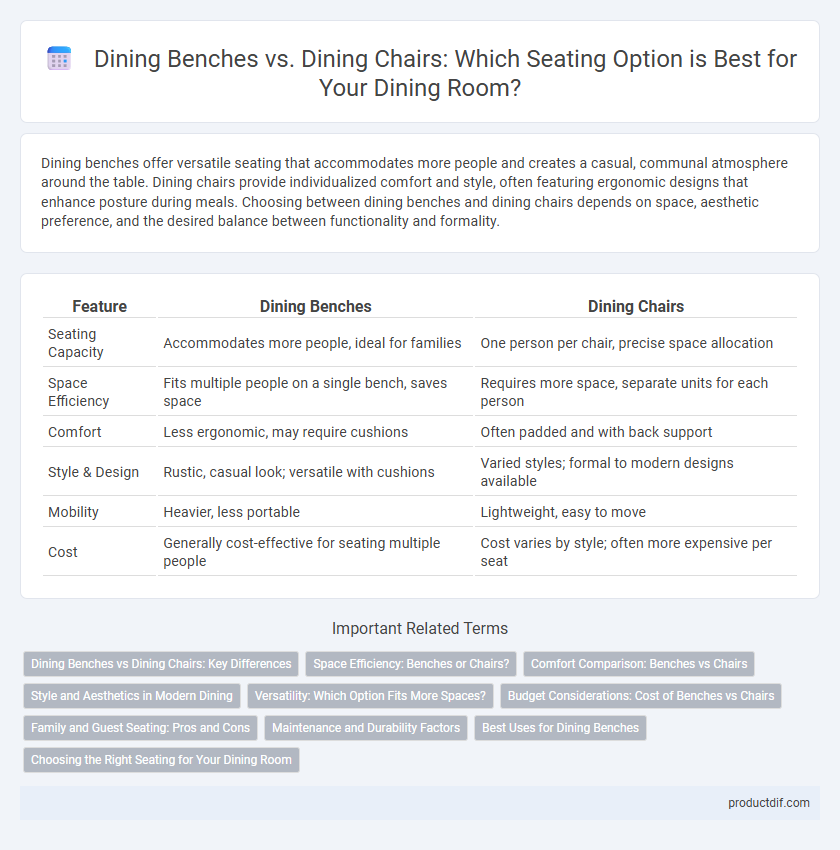Dining benches offer versatile seating that accommodates more people and creates a casual, communal atmosphere around the table. Dining chairs provide individualized comfort and style, often featuring ergonomic designs that enhance posture during meals. Choosing between dining benches and dining chairs depends on space, aesthetic preference, and the desired balance between functionality and formality.
Table of Comparison
| Feature | Dining Benches | Dining Chairs |
|---|---|---|
| Seating Capacity | Accommodates more people, ideal for families | One person per chair, precise space allocation |
| Space Efficiency | Fits multiple people on a single bench, saves space | Requires more space, separate units for each person |
| Comfort | Less ergonomic, may require cushions | Often padded and with back support |
| Style & Design | Rustic, casual look; versatile with cushions | Varied styles; formal to modern designs available |
| Mobility | Heavier, less portable | Lightweight, easy to move |
| Cost | Generally cost-effective for seating multiple people | Cost varies by style; often more expensive per seat |
Dining Benches vs Dining Chairs: Key Differences
Dining benches offer versatile seating that maximizes space efficiency, accommodating more people compared to individual dining chairs. While dining chairs provide personalized comfort with varying backrest heights and cushioning options, benches promote a communal dining experience with a sleek, minimalist design. Material and style choices differ, as chairs often feature intricate detailing and upholstery, whereas benches emphasize sturdy, simplistic construction ideal for casual and modern dining rooms.
Space Efficiency: Benches or Chairs?
Dining benches maximize space efficiency by accommodating more people along a single side of the table, making them ideal for smaller dining areas or flexible seating arrangements. Dining chairs offer individualized seating with defined personal space but typically require more room due to their separate frames and spacing needs. Opting for benches can significantly enhance seating capacity without increasing the dining area footprint.
Comfort Comparison: Benches vs Chairs
Dining chairs offer individualized back support and cushioning, enhancing comfort during extended meals. Benches provide flexible seating capacity but often lack ergonomic features like backrests, which can reduce long-term comfort. For families prioritizing comfort, upholstered dining chairs with lumbar support generally outperform benches in promoting proper posture and reducing fatigue.
Style and Aesthetics in Modern Dining
Dining benches offer a sleek and minimalist aesthetic that complements modern dining spaces by promoting a communal and casual atmosphere. Their clean lines and versatile designs provide a streamlined look, enhancing the room's openness compared to the more individualistic and often ornate styles of dining chairs. Dining chairs, available in a wider variety of materials and shapes, allow for personalized style statements and add texture and visual interest to contemporary dining rooms.
Versatility: Which Option Fits More Spaces?
Dining benches offer greater versatility by accommodating more people in various seating arrangements, making them ideal for both small and large dining areas. Their streamlined design fits well against walls or under tables, maximizing floor space and adapting to casual or formal settings. Dining chairs provide individualized seating with flexibility for easy movement and rearrangement, but benches excel in multifunctional spaces needing compact, communal seating solutions.
Budget Considerations: Cost of Benches vs Chairs
Dining benches typically offer a more budget-friendly seating option compared to individual dining chairs, often accommodating multiple people at a lower cost per seat. While chairs vary in price depending on materials and design, benches usually have a simpler construction that reduces manufacturing expenses. Opting for benches can maximize seating capacity and style without significantly increasing your furniture budget.
Family and Guest Seating: Pros and Cons
Dining benches maximize seating capacity and foster a communal atmosphere, making them ideal for families and guests during gatherings. Dining chairs offer individualized comfort and style, accommodating diverse preferences and enhancing formal dining experiences. Families benefit from benches' space efficiency, while chairs provide versatility for mixed-age groups and easier mobility.
Maintenance and Durability Factors
Dining benches generally require less maintenance due to their simpler design with fewer moving parts, reducing wear and tear over time. Made from hardwood or metal, benches often exhibit greater durability and resistance to damage compared to upholstered dining chairs that need regular cleaning and fabric care. Choosing furniture materials like solid wood or powder-coated steel enhances longevity and minimizes maintenance efforts in both benches and chairs.
Best Uses for Dining Benches
Dining benches maximize seating capacity by accommodating more people compared to individual dining chairs, making them ideal for family gatherings and smaller dining spaces. Their versatile design allows easy movement and can be tucked under the table to save space when not in use. Popular in rustic, farmhouse, and modern dining rooms, benches provide a casual and communal dining experience.
Choosing the Right Seating for Your Dining Room
Dining benches maximize seating capacity and create a communal atmosphere, making them ideal for families and gatherings, while dining chairs offer individual comfort and style customization to suit diverse interior designs. Consider the size and shape of your dining table, the room layout, and your lifestyle needs when selecting between benches and chairs to optimize both functionality and aesthetic appeal. Materials such as wood, upholstered cushions, or metal frames influence durability and maintenance, so choose seating that complements your dining room's decor and usage frequency.
Dining Benches vs Dining Chairs Infographic

 productdif.com
productdif.com